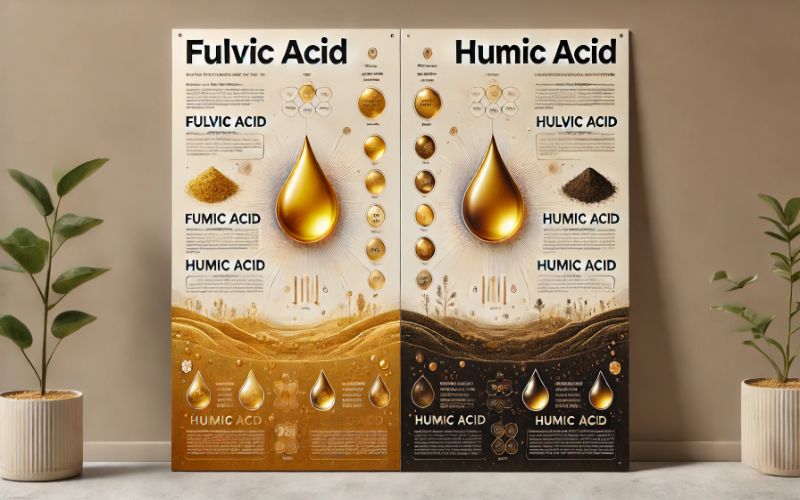
Fulvic Acid vs. Humic Acid - Comprehensive Guide
If you are interested in soil health, farming, or natural supplements, you may have heard of "fulvic acid" and "humic acid." These two compounds are often mentioned together but have different properties and uses. Both are important for enriching soil, boosting plant health, and benefitting humans. But what makes them different?
In this blog, we’ll explore the differences between fulvic acid and humic acid, including their chemical compositions, benefits, and how they are used in agriculture and health products. We’ll also closely examine two of Vital Earth Minerals' products—Fulvic Minerals (FM) and Humic Minerals (HM)—to provide a practical example of how these substances are formulated for everyday use.
Fulvic Acid
Fulvic acid is a smaller and more bioactive molecule compared to humic acid. It is soluble in alkaline and acidic conditions, so it can easily dissolve in water and be absorbed by plant roots. It is a powerful compound known for its ability to chelate (bind) minerals and transport them directly to cells, tissues, and plant roots. This makes fulvic acid an excellent carrier for essential nutrients, ensuring that plants receive the minerals they need for growth and development.
From a human health perspective, fulvic acid is also lauded for its antioxidant properties, ability to improve nutrient absorption, and potential to detoxify the body. It’s often found in supplements designed to boost energy, enhance immune function, and support overall wellness.
Humic Acid
Humic acid, on the other hand, is a larger and more complex molecule. Unlike fulvic acid, it is not water-soluble and works best in neutral to alkaline environments. Humic acid plays a vital role in soil structure, improving water retention, soil aeration, and the soil's overall health by fostering microbial life.
Humic acid’s benefits for human health are less common but still notable. It may help support detoxification and reduce sensitivity, though it is mainly known for improving the soil's long-term fertility.
Key Differences Between Fulvic Acid And Humic Acid
Though fulvic acid and humic acid are derived from the same source, their chemical structures and properties differ significantly. Let’s break down the primary differences:
1. Molecular Size and Solubility
- Fulvic Acid: Fulvic acid has a smaller molecular structure, making it more bioavailable and easily absorbed by plants, soil, and the human body. It is soluble in acidic and alkaline environments, so it can easily move through soil or water and be absorbed by plant roots and human cells.
- Humic Acid: Humic acid has a larger, more complex molecular structure. It is not water-soluble and is more effective in neutral to alkaline conditions. While it improves soil texture and helps retain moisture and nutrients, it is less readily absorbed by plants or organisms.
2. Functions in Soil
- Fulvic Acid: Due to its smaller size, fulvic acid is a powerful chelator, helping plants absorb more minerals and nutrients. It is highly effective at moving through plant membranes and helping deliver vital nutrients like iron, magnesium, and calcium directly to plant cells.
- Humic Acid: Humic acid improves soil structure, increases water retention, and promotes microbial activity. Healthy soil supports the growth of organisms that help break down natural matter. This process makes nutrients available to plants over time.
3. Impact on Plant Growth
- Fulvic Acid: Plants exposed to fulvic acid often show faster growth rates, better nutrient uptake, and improved resistance to stressors like drought or discomfort. It can also increase the effectiveness of fertilizers, reducing the need for chemical additives.
- Humic Acid: Humic acid contributes to long-term plant health by improving soil quality, enhancing root development, and boosting the plant's ability to access nutrients. Its benefits are more gradual and focused on building overall soil fertility.
4. Human Health Benefits
- Fulvic Acid: Known for its potent antioxidant properties, fulvic acid is often used in health supplements aimed at detoxifying the body, improving gut health, boosting energy, and enhancing nutrient absorption. Its small molecular structure allows it to easily pass through cell membranes, delivering nutrients where they’re needed most.
- Humic Acid: While humic acid may offer some detoxifying and soothing benefits, its use in human health is less common than fulvic acid. It is primarily used to support overall soil health and plant growth rather than as a direct supplement for human consumption.
Vital Earth Minerals’ Fulvic and Humic Products
Vital Earth Minerals offers two products that leverage the power of fulvic and humic acids to support plant health and human wellness: Fulvic Minerals (FM) and Humic Minerals (HM).
Fulvic Minerals (FM)
FM is a natural, highly concentrated source of fulvic acid. This product is designed to provide a bioavailable form of essential minerals and trace elements easily absorbed by the body. It can help improve nutrient absorption, support energy levels, and promote overall well-being. Due to its high solubility, FM can also be used as a soil amendment, enhancing plant growth and vitality by facilitating better mineral uptake.
Some key benefits of Fulvic Minerals (FM) include:
- Enhanced nutrient absorption for plants and humans
- Improved immune system function
- Antioxidant properties to fight free radical damage
- Increased energy levels and mental clarity
Unlock the power of Fulvic Minerals for enhanced health and vitality!
Humic Minerals (HM)
HM is formulated using humic acid, a powerful substance for improving soil structure and fertility. This product enhances the biological activity of the soil, improves plant growth over time, and supports sustainable agricultural practices. While primarily used for agriculture, it can also improve soil health in gardens, lawns, and other plant-rich environments.
Some key benefits of Humic Minerals (HM) include:
- Improved soil texture and water retention
- Better root growth and plant resilience
- Enhanced nutrient uptake by plants
- Long-term improvement in soil fertility
Verdict: Fulvic vs. Humic Acids
In conclusion, both fulvic and humic acids are vital for improving soil health, enhancing plant growth, and supporting human wellness. Fulvic acid, being smaller and more bioactive, is ideal for immediate nutrient absorption and cell transport. In contrast, humic acid best suits long-term soil enrichment and improved root development. The choice between the two depends on whether you want to enhance short-term plant health (fulvic acid) or build long-term soil fertility (humic acid).
Depending on your specific needs, Vital Earth Minerals' fulvic (FM) and Humic (HM) Minerals offer unique benefits that help optimize personal health.
Frequently Asked Questions
Can I use Fulvic Acid and Humic Acid together?
Yes, using fulvic acid and humic acid together can provide complementary benefits. Fulvic acid aids nutrient absorption, while humic acid improves soil structure and fertility. Many gardeners and farmers use both to enhance soil health and plant growth.
What are the main benefits of Fulvic Acid for human health?
Fulvic acid is known for its antioxidant properties and ability to improve nutrient absorption, boost energy, and support detoxification. It helps the body absorb minerals more effectively and may enhance immune function and gut health.
How long does it take to see results from using Humic Acid in the soil?
Results can take a little longer to manifest. Humic acid works by improving the long-term structure and fertility of the soil, so visible improvements in plant health may take a few weeks to months. However, the long-term benefits are significant for sustained plant growth.

